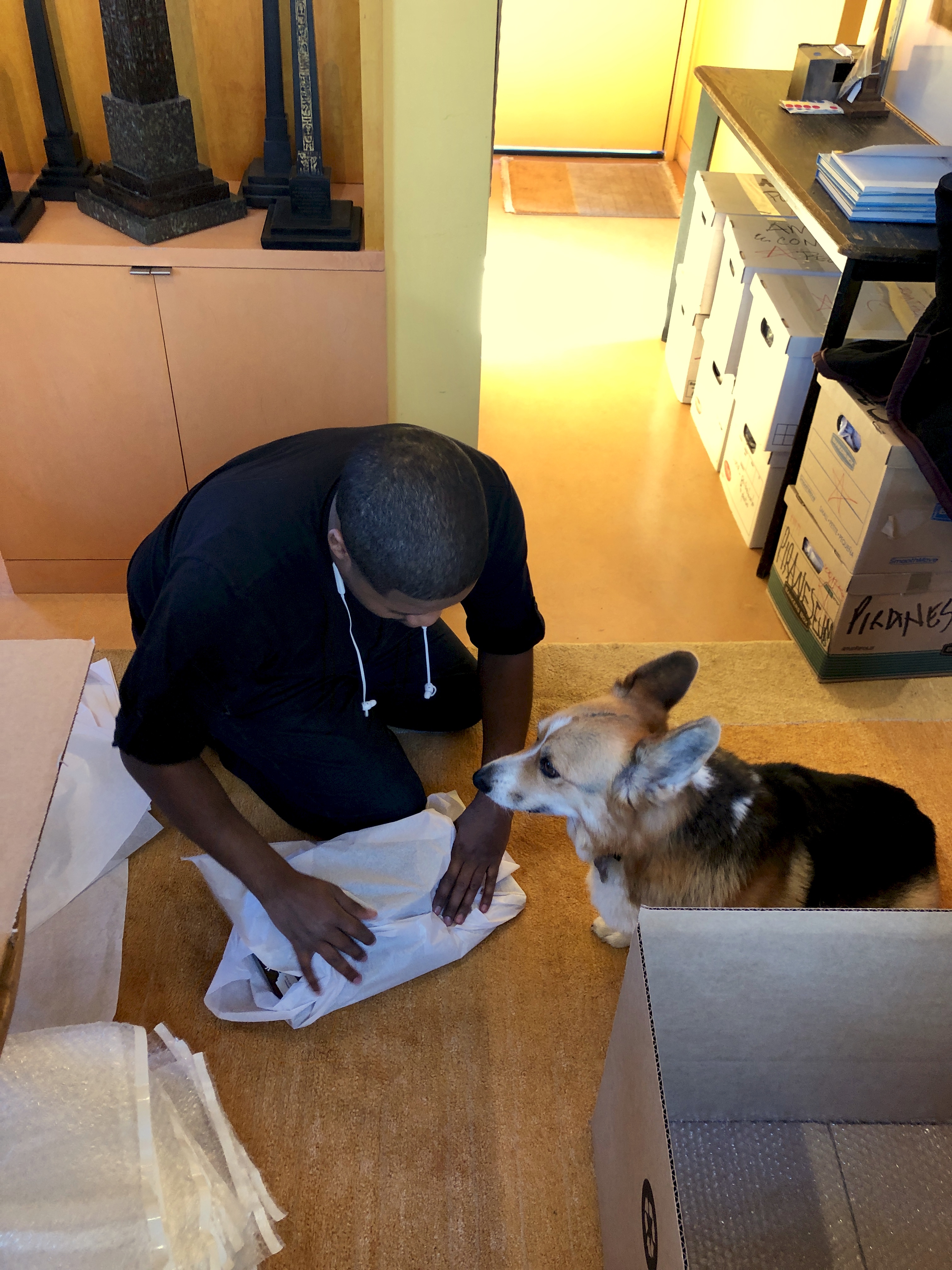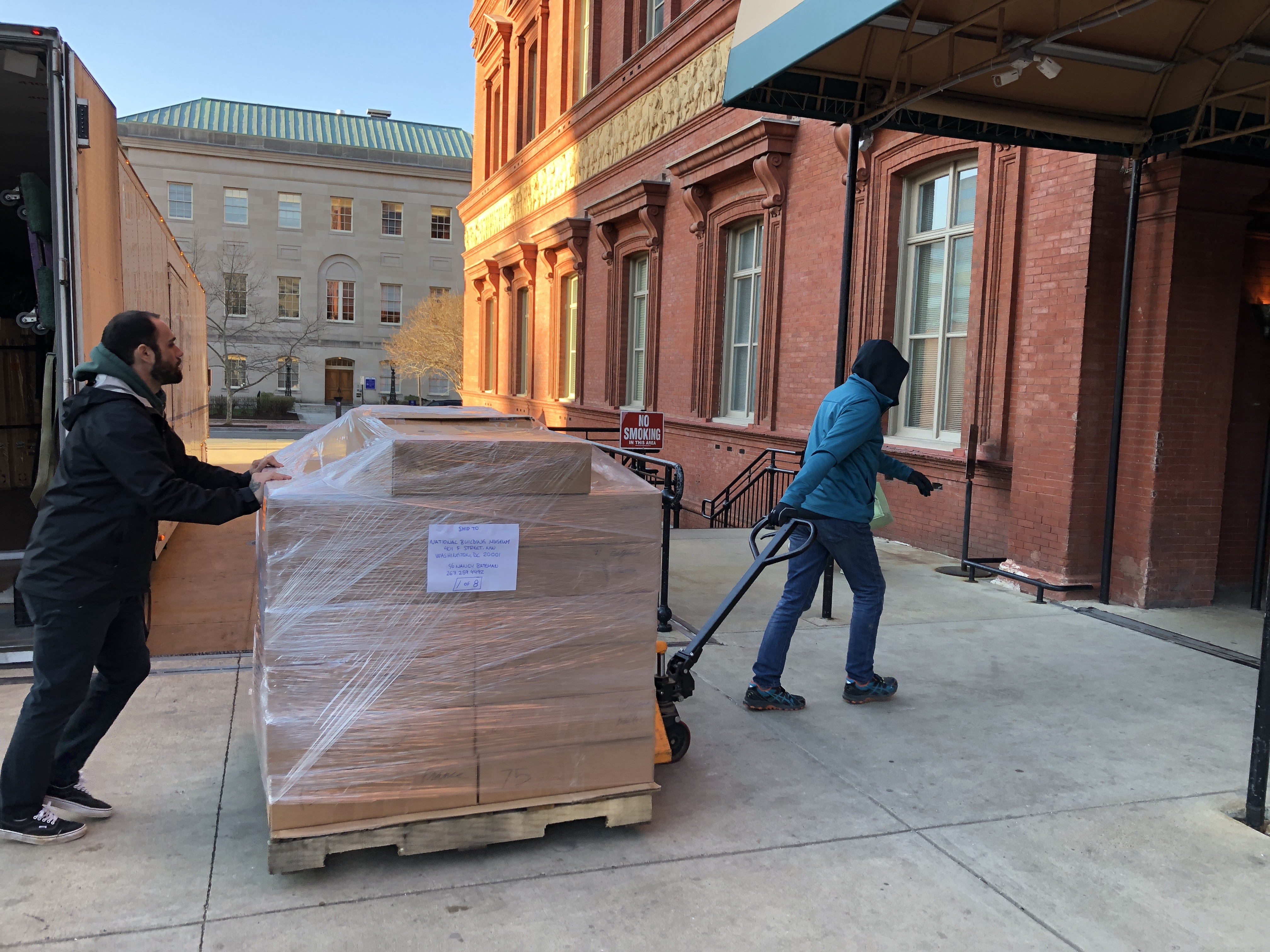The Grand California Tour

By Nancy Bateman, Registrar
Last month the National Building Museum’s collections department staff and volunteers spent ten days in California packing up our newest donation: the 3,069-piece 20th Century Souvenir Buildings Collection, donated by David Weingarten. It was a herculean task but we had a great team assembled: chief preparator Hank Griffith and Museum volunteer Karen Griffith, operations assistant Daniel Stewart, and myself, registrar Nancy Bateman. All together, we have over 40 years combined tenure at the Museum—and even so, this was an unprecedented trip for our team.
Day 1
We arrived in California on a Sunday and took a lovely drive through the city of San Francisco to Lafayette. Hank and Karen had never been to California and Daniel hadn’t visited in years, while I’m from Northern California so I was coming home. We stopped at the grocery, got settled into our AirBnb and prepared for the next day—we had a busy week ahead!
Day 2
On Monday morning we headed to the donor’s house to finally meet them in person and see the entirety of the collection for the first time. From their driveway there was a spectacular view of the valley below—not too shabby of a workplace for the next 7 days! When we walked in, I was immediately greeted by their Corgi, Cowboy: I have two Corgis myself and took Cowboy’s presence as a sign of a successful trip! After a quick tour of the beautiful house and garden we got set up in their gallery wing and got to work.
A registrar’s dream, the donors had organized and cataloged the entire collection for us before we arrived. This is not how most donations come in: usually we have to measure, photograph, and describe each artifact as it is packed. We then create detailed records about each piece once they arrive at the Museum. But in this case, the donors created a list of all 3,069 souvenir buildings, each with its own inventory number, the name of the building, where that building was located, the measurements of the model, the material it was made from, and any other pertinent information. The donors had also photographed each model and separated the entire collection into categories based on locations, events, the purpose of the souvenir, and the manufacturers. It was a huge feat that took them over a year to complete. It made our packing process a lot smoother.
75 percent of the souvenir buildings are smaller than 6 inches tall but they are quite heavy, so we had to pack them in a way that prevented the boxes from crushing each other. We decided to use large, shallow boxes (2 feet x 2 feet x 6 inches high) so that we could pack the buildings in either a single or double layer. Each individual model was wrapped in paper and then placed in a self-sealing bubble wrap bag. Since each souvenir building already had a number assigned to it, we were able to quickly make inventory lists for each box. Using the list of souvenir buildings provided by the lender before we left for California, Hank had pre-ordered the packing supplies and they were waiting for us when we arrived.

We split into two teams: Hank and Karen as one pair and Daniel and I as the other. For each team, one person would take a souvenir building off the shelf (or out of a drawer or box, depending on where it was stored) and read its inventory number off for the second member of the team to record on the inventory sheet for the box. Then the model was wrapped in paper, wrapped in bubble wrap, and placed in the box. We were in a tight work space so Hank and Karen worked in the main gallery room while Daniel and I worked in an additional display room.
Our goal was to pack 500 souvenir buildings a day. On Monday we packed 479—doing well!
Days 3 and 4
On Tuesday and Wednesday we continued working in our teams as Hank and Karen packed buildings related to New York and World’s Fairs and then moved on to the hundreds of banks organized by specific manufactures. Daniel and I tackled smaller categories, such as buildings from Washington, D.C. and Chicago, and then started working through various American commercial structures: historic houses, state capitals, stadiums, bookends, pencil sharpeners, salt and pepper shakers, thermometers, and unidentified buildings.
By the end of the day on Wednesday we’d packed 1,681 souvenir buildings into 61 boxes!
Days 5 and 6
At the beginning of the day on Thursday we needed to stop and take a moment to reorganize. The donors had graciously cleared space in their garage for us to store the finished boxes and we needed to start packing them onto pallets for their journey across the country. In addition to the souvenir buildings they’d collected, the donors also had over 100 cast iron molds used to actually create some the individual souvenirs. These weighed about 20 pounds each and were packed in crates also in the garage. We moved the crates onto pallets and then strapped them down for stability. We also realized that we needed to start planning ways to pack the models that were larger than our 6 inch high boxes. Luckily, the donors knew of a great small packing business in Lafayette who supplied us with larger boxes and rolls of bubble wrap for the bigger models. The donors also had a great deal of their collection stored in 12 inch tall banker’s boxes and we started reusing those as well. We were able to pack almost all of the remaining souvenir buildings in these larger boxes.
Over the next two days Hank and Karen “moved to Europe.” Meanwhile, Daniel and I traveled to Cuba, South America, Africa, the Middle East, Australia and Canada, then we popped over to Japan, China, Southeast Asia, and the Philippines. The models of temples and mosques were each more beautiful than the next!

Day 7
On Saturday we had only 16 souvenir buildings left to pack but we’d left the most challenging for last. We had everything from 4 foot tall radio towers to monuments of sword wielding saints to a three foot tall Gothic-Renaissance style German city hall. Each was tall or top heavy or overly fragile (or all three!) and required custom boxes and packing. We returned to the shipping store with a list of oddly sized boxes we needed (fun fact: lamp boxes are perfect for storing model radio towers!) and then headed back to the donor’s house to pack these final pieces.
As Hank and Daniel created custom boxes and mounts for the last few souvenir buildings, Karen and I went over all the inventory lists, recounted all of our totals, and put additional labels on all of the boxes in the garage. Together we loaded the final boxes on the pallets and shrink wrapped each grouping for additional stability.
All told, we packed 3,069 souvenir buildings in 125 boxes 6 days.We went back to our Airbnb that evening to celebrate our accomplishment—and also Hank and Karen’s 45th wedding anniversary—with cocktails on the deck.
Day 8
Having finished early we had a day off to explore northern California. We went back into San Francisco, taking a detour to drive over the Golden Gate Bridge before parking at the Presidio to visit the Palace of Fine Arts, an amazing architectural remnant from the 1915 World’s Fair. We meandered along the beach and visited with the famous Pier 39 sea lions. As we walked past the tourist shops and saw various souvenirs in the windows, we wondered if 100 years from now a team of Museum employees would travel to pack up a collection of souvenirs from the 21st century. What a task that would be!
Day 9
On Monday morning, exactly one week after we’d first arrived at the donor’s house, we sat outside in the sunshine waiting for the art shipping company to come and pick up the collection. In the end it was five pallets of boxes, two large “bin boxes” filled with oversized boxes and individually packed models, plus one small crate holding additional molds. The shippers arrived promptly and loaded up the souvenir buildings for their journey to Washington, D.C.
We said a final goodbye and thank you to the donors for graciously hosting us the past week and especially for donating the amazing collection to the National Building Museum. After a brief rest back at the Airbnb and a final “family” meal all together that night, we packed our suitcases and headed home on Tuesday morning.

Day 10
Nine days later, on an unseasonably cold March morning, the collection arrived at the National Building Museum. Our staff rolled the pallets and boxes up to our secure collections storage area and into our collections processing room—the souvenir buildings are safe in their new home!
Starting next week, Karen and I will begin the meticulous process of unwrapping the souvenir buildings, checking their information one final time against the donor’s spreadsheet, and placing them on the new shelving we’ve purchased. We’ll keep you updated as this project and journey continues. In the meantime, be sure to check out the four souvenir buildings featured in our Animals, Collected exhibition on the second floor. They are a sneak peak of what’s to come!
